With the advent of cryptocurrency technologies in our lives, many tools and solutions for working with them have appeared. One such tool today is cryptocurrency exchanges, which are presented in two groups: decentralized and centralized exchanges. How do they differ?
Centralized exchanges can be used to settle transactions: change fiat for cryptocurrency (or vice versa). Users can also apply it to make transactions between two diverse cryptocurrencies.
Decentralized exchanges work alternatively. They do not have an intermediary (3rd party owner of the exchange). These types of exchanges operate as peer-to-peer trading platforms. The service never holds assets. Transactions and trades are carried out exclusively based on smart contracts and atomic (cross-chain) swaps.
In this article, we will explore the key features of each type of exchange and discover their use cases, famous examples, and more.
What is a cryptocurrency exchange?
A cryptocurrency exchange is an online platform that facilitates the buying, selling, and trading of cryptocurrencies. On these platforms, users can exchange digital assets like Bitcoin, Ethereum, or altcoins for fiat currencies (such as USD and EUR) or other cryptocurrencies.
Most cryptocurrency exchanges provide additional features like wallet services, staking, margin trading, and market analysis tools to help users make informed decisions. They also implement various security measures to protect users’ funds, including encryption, two-factor authentication (2FA), and cold storage options.
There are two main types of exchanges we will consider in this article – decentralized (DEX) and centralized (CEX). Comparing CEX vs DEX crypto platforms, you will gain a more comprehensive understanding of their characteristics and functionalities.
What is a centralized cryptocurrency exchange (CEX)?
As their name suggests, CEXs are operated by a single entity that primarily acts as an intermediary between two parties – sellers and buyers.
How does a centralized exchange work?
Let’s imagine a user who aims to purchase Bitcoin. A user can go to the exchange, register with their bank details, complete KYC (Know Your Customer) verification (if required), and deposit cash. The exchange will show them the cost based on an “order book” of people purchasing and selling for diverse amounts. After that, users can make a transaction to buy Bitcoin for the amount listed on the exchange.
Next, the exchange will show the Bitcoins the user purchased in their account, and they can exchange them for other tokens on the platform. But a user doesn’t actually hold them because they’re instructing the CEX to operate as a repository on their behalf. Any trading users do, such as exchanging Bitcoin for Ethereum, does not happen on the blockchain vs hashgraph but on the exchange’s database.
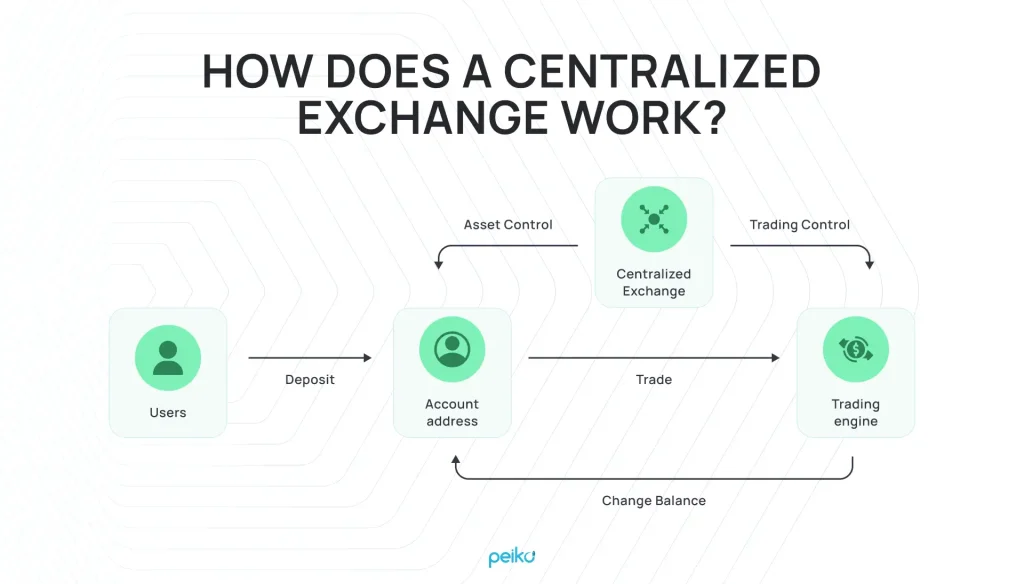
Use cases of centralized exchanges
In our guide on the DEX CEX comparison, we came to the topic of CEX use cases. Centralized exchanges provide an array of services tailored to meet the diverse requirements of users:
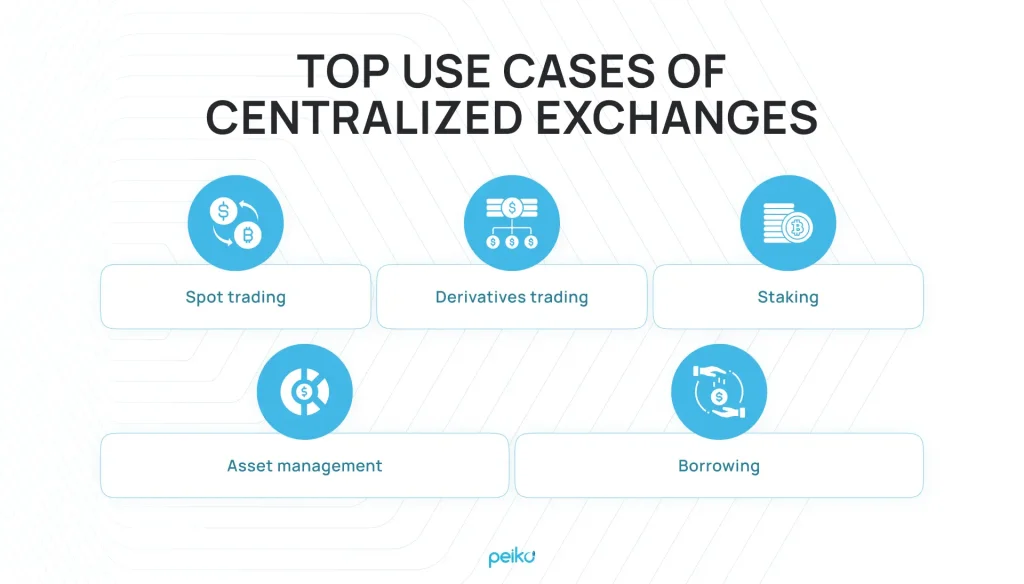
Spot trading
CEXs provide a user-friendly platform for spot trading, enabling users to shop and sell a variety of cryptocurrencies for immediate delivery. This straightforward process attracts both beginners and experienced traders. In turn, this contributes to the efficiency and liquidity of the crypto market.
Derivatives trading
Beyond spot trading, some CEXs offer sophisticated options such as futures and perpetual contracts. These derivative instruments enable traders to engage in more complex strategies, including hedging and leverage, enhancing the diversity of trading options available on the platform.
Staking
It is a process where users actively participate in the blockchain network’s operations, facilitated by CEXs. Users lock up their crypto holdings to support network functions, earning additional tokens as rewards. This benefits individual users and contributes to blockchain’s general security and decentralization.
For example, CEXs like Gemini, Binance, Coinbase, KuCoin, and Kraken enable cryptocurrency users to stake their assets and earn staking rewards, providing an avenue for passive income.

Asset management
CEXs are instrumental in providing asset management services, catering to users who prefer a hands-off approach to their crypto holdings. Entities like Grayscale Investments and others manage crypto assets on behalf of clients, offering various investment products and opportunities.
Borrowing
CEXs specializing in crypto loans offer a unique service where users can borrow funds against their crypto assets. By using their holdings as collateral, users can access liquidity without trading their crypto. This borrowing mechanism provides flexibility for users who need funds while maintaining their long-term crypto investments. There are many CEXs specializing in cryptocurrency loans, such as Nebeus or CoinRabbit.
Features of CEX
In this section of our comparison of DEX vs CEX, we will consider CEX features. Centralized crypto exchanges have many advantages, which is why they remain extremely popular:
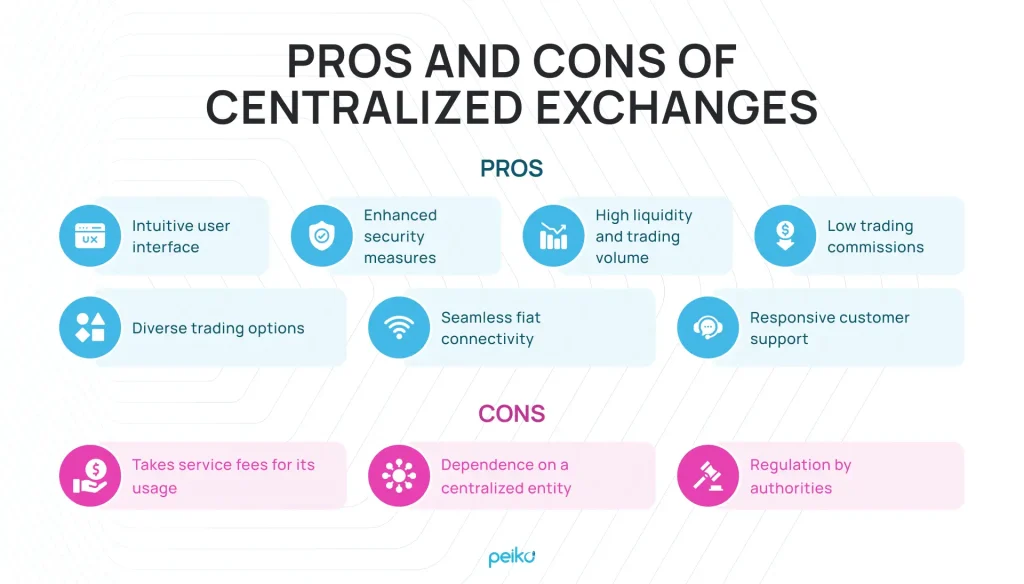
Pros:
Intuitive user interface: Centralized exchanges are known for their user-friendly interfaces, catering to novice traders. The ease of navigation allows users to efficiently conduct trades, manage portfolios, and engage in various activities without facing a steep learning curve.
Enhanced security measures: CEXs implement robust security protocols to safeguard user assets and accounts. Safety is provided by features such as 2FA (two-factor authentication), encryption, and secure wallet storage. The centralized model enables stringent security practices, lowering the risk of unauthorized access or security incidents. Also, these exchanges have a KYC verification system to confirm the individuals’ identities.
High liquidity and trading volume: Traditional exchanges boast significant liquidity and trading volumes. This ensures users can execute trades promptly at desired prices, minimizing slippage. The high liquidity also guarantees the availability of buyers or sellers for most trading pairs, enhancing overall trading efficiency. This is one of the essential benefits of CEX in the comparison of centralized vs decentralized crypto exchange.
Diverse trading options: Centralized exchanges (CEXs) stand out by providing an extensive selection of trading opportunities. This allows users to explore diverse markets and engage with numerous cryptocurrency pairs. The broad spectrum of trading options not only facilitates portfolio diversification but also empowers users to navigate various market dynamics. This versatility caters to both beginners and skilled traders, offering a comprehensive trading environment with a broad range of digital assets to select from.
Seamless fiat connectivity: The ease of transitioning between cryptocurrencies and fiat currencies is a notable feature. Numerous centralized exchanges enable users to deposit and withdraw funds in conventional fiat currencies like USD, EUR, and more.
Responsive customer support: Many centralized exchanges provide customer support services to address user queries, account-related issues, and other concerns. Direct support can be invaluable for users seeking quick assistance and resolutions to challenges encountered while using the platform.
Low trading commissions: CEXs typically offer very low or no trading commissions, as users don’t need to pay gas fees, which are usually required on decentralized exchanges.
Cons:
Takes service fees for its usage: Most services charge users when they apply them. Sometimes, these fees are hidden, and sometimes, they are built into the service itself, so they are not immediately detectable.
Dependence on a centralized entity: User assets are under the control of the exchange. If the site goes bankrupt, clients may lose all their funds. One of the examples is the FTX exchange, where the centralized crypto exchange managers use clients’ assets for personal enrichment.
Regulation by authorities: CEXs are increasingly subject to audits and pressure from government agencies. This can freeze or confiscate customer funds and force exchanges to make users’ personal data public.
Centralized exchanges examples
- Binance: Largest cryptocurrency exchange. Ranks first in terms of trading volume ($59 billion).
- Kraken: Known for its security and wide range of cryptocurrencies. $2 billion in trading volume.
- Gemini: Priorities security and compliance. Has a trading volume of $326 million.
- Coinbase: One of the top exchanges globally. Trading volume, according to CoinGecko: $9 billion.
The Peiko team will help.

What is a decentralized cryptocurrency exchange (DEX)?
The DeFi (decentralized finances) sector is gaining popularity, and many authoritative sources, such as Statista, confirm this. This research website states that the number of users in the DeFi market is projected to amount to 22.09 million users by 2028. Decentralized exchanges are one of the main trends in the DeFi field.
A decentralized exchange is a platform that enables individuals to manage their own funds fully. In addition, there are no intermediaries in such a type of exchange.
By the way, at Peiko, we know all about emerging trends in decentralized technologies like DeSci and beyond. Our expertise allows us to navigate and implement the latest advancements in these areas with confidence.
How does a decentralized exchange work?
To understand the difference between CEX and DEX, we should explain how DEXs work. For example, a user wants to trade a cryptocurrency that runs on the Ethereum blockchain. First, they need to find an Ethereum-based DEX, such as Uniswap. There is a wide choice of trading pairs on such platforms.
A user should then connect their personal wallet to the exchange and place an order. The DEX will execute the order using AMM (automation market maker) funds, and the user’s trade will be completed. The tokens will go directly into the user’s personal wallet without the need for deposits or withdrawals.
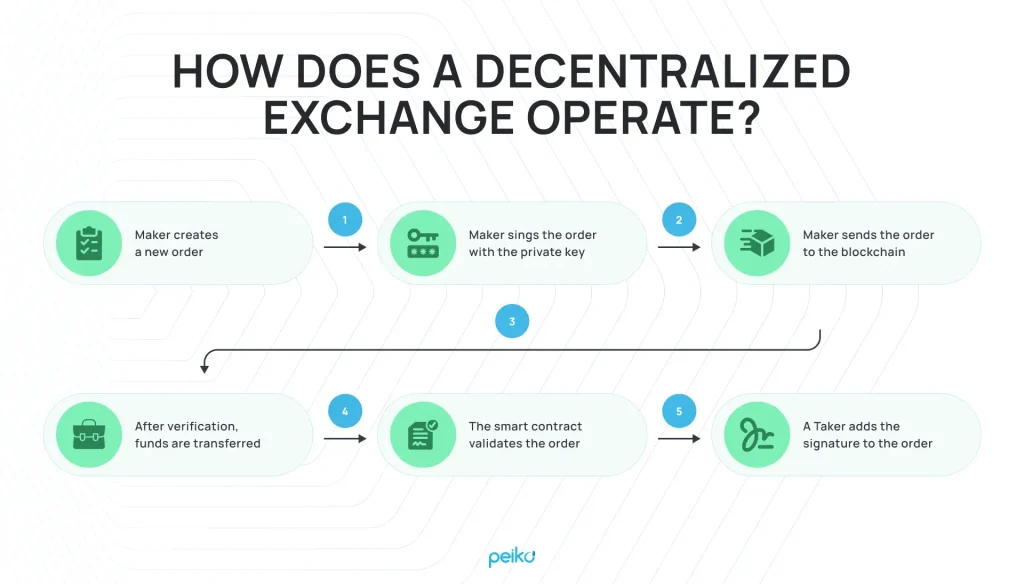
Use cases of decentralized exchanges
Now, let’s explore the use cases that distinguish decentralized exchanges in the CEX vs DEX crypto comparison:
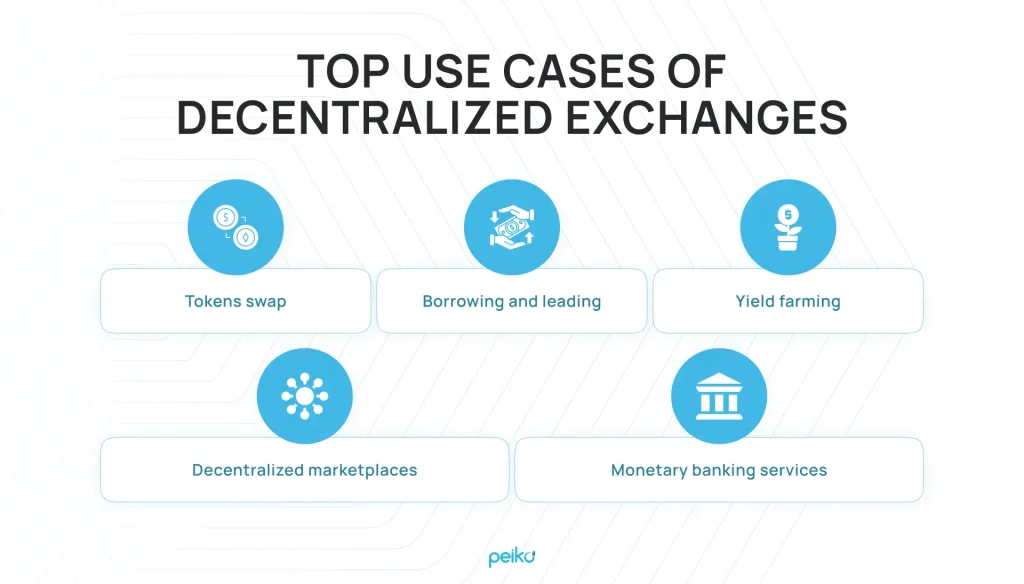
Tokens swap
DEX platforms excel in their ability to facilitate rapid token swaps. Whether a user aims to exchange cryptocurrencies directly or engage in decentralized finance activities, DEX platforms provide a direct and efficient avenue for completing these transactions without the need for intermediary involvement.
Borrowing and lending
A prevalent use case within DeFi involves open lending protocols. DeFi lending and borrowing offer advantages such as rapid settlement, no KYC requirements, minimal to zero collateral needs for borrowing, and the absence of credit checks. Transactions unfold on a peer-to-peer blockchain.
Yield farming
Yield optimization, synonymous with yield farming, employs data analytics and optimization techniques. DeFi software automates and optimizes yield compoundings from interest-bearing assets such as pooling, staking, and others. Computational strategies are employed to maximize rates on crypto transactions, enhancing the overall returns in yield optimization.
Monetary banking services
DeFi serves as a noteworthy use case for monetary banking services, encompassing straightforward mortgage offerings, stablecoin issuance, and insurance.
As the blockchain industry expands, new trends like DePIN emerge, the demand for fiat-backed stablecoins grows. Traditional mortgage services often involve intermediaries, incurring costs and time delays. Smart contracts on public or permitted blockchains substantially reduce legal and underwriting charges.
Decentralized marketplaces
DeFi’s most widespread applications manifest in decentralized marketplaces or exchanges. Traders can seamlessly join decentralized exchanges like Uniswap and PancakeSwap, facilitating lending, borrowing, or trading of crypto assets without intermediaries.
Features of DEX
To continue our comparison of DEX vs CEX, let’s consider the benefits that decentralized ones provide. Most of the strengths of decentralized exchanges come from their distributed structure. Here are a few advantages that encourage crypto owners to choose them:

Pros:
Enhanced anonymity: What is the main difference between CEX and DEX? DEXs operate on principles that prioritize user privacy with minimal data requirements. The absence of centralized accounts and the utilization of blockchain technology contribute to increased anonymity for traders.
Reduced counterparty risk: By facilitating peer-to-peer transactions through smart contracts, DEXs minimize counterparty risk. Traders retain control over their assets until the moment of trade execution, reducing reliance on intermediaries and enhancing overall security.
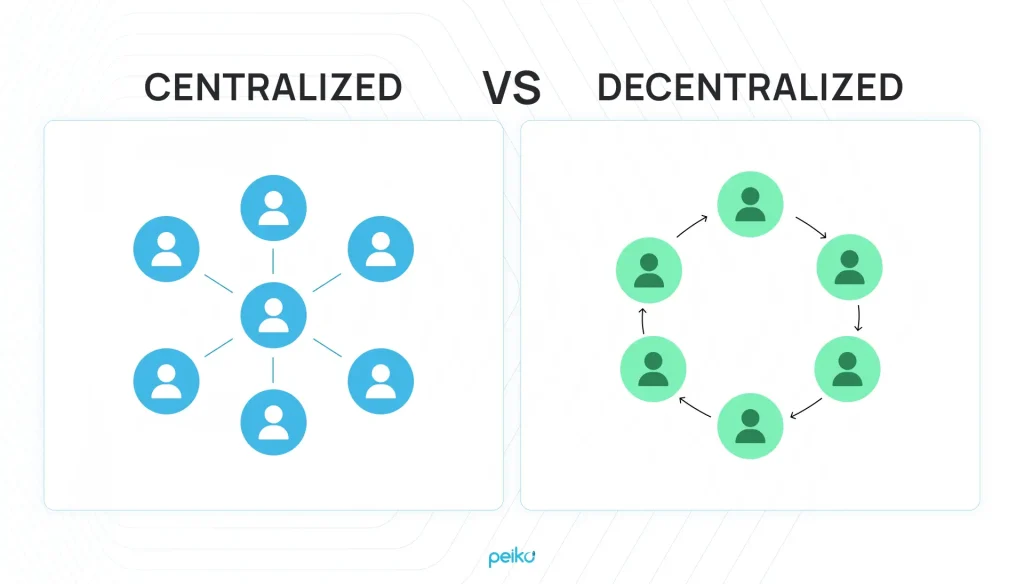
Security through decentralization: The decentralized nature of DEXs leverages blockchain’s inherent security features. This cuts the risk of centralized points of failure. Furthermore, decentralization improves the resilience and robustness of the platform against possible security vulnerabilities.
Global accessibility: When comparing CEX vs DEX, DEXs typically offer global accessibility, allowing users worldwide to participate without stringent geographic restrictions. This inclusive approach aligns with the decentralized finance philosophy, providing fintech opportunities to a broader global audience.
Permissionless trading: Users can engage in trading on DEXs without the need for complex approval processes. The permissionless nature of DEXs aligns with the core principles of decentralized finance, offering financial access without traditional barriers.
Resilience to regulatory changes: The decentralized structure of DEXs may contribute to resilience in the face of certain regulatory changes. Users can continue trading without immediate interference from external regulatory authorities.
However, regulatory authorities of the European Union and a number of countries, in particular the USA, China, and Singapore are today working on the creation and implementation of legislative acts at local levels to oversee all existing decentralized platforms and trade transactions carried out on them.
Cons:
Difficulties in starting to use: Users first need to learn all its functionality. Any error related to crypto wallet data, sending funds to addresses, paying commissions, or other actions can be costly for the DEX user.
Lower liquidity: Decentralized exchanges tend to have less liquidity compared to CEXs. Therefore, when purchasing or trading large positions in low-liquidity pairs, individuals may face so-called price sliding. This means executing a transaction at a price that differs from the one set in order for the worse, which reduces user benefits.
Limited trading options: Decentralized exchanges have limited trading features and do not have the usual options such as different order types (for example, Buy Limit, Sell Limit, Stop Loss, Sell Stop, Buy Stop, Take Profit) or margin trades. This can make it much more challenging to follow a trading strategy, which can lead to losses. Also, decentralized exchanges do not have additional tools such as tape (record of all stock transactions), market depth, or order book.
Slower transaction speed: The transaction speed on decentralized exchanges (DEX) can occasionally face challenges attributed to the decentralized nature of the platform and its reliance on blockchain technology. Factors such as network congestion and block times may contribute to variations in transaction speed, which might not align with the swift execution expectations of traders accustomed to centralized exchanges.
Higher transaction costs: Users of decentralized exchanges must pay gas fees for every transaction, which can become expensive, especially during periods of high network traffic.
Security risks: DEXs may have weaker security due to their limited resources and less experienced development teams, making them more vulnerable to potential exploits compared to larger centralized exchanges. This does not apply to such proven projects as Uniswap, for example.
Decentralized exchanges examples
- Uniswap: DEX on the Ethereum blockchain. Trading volume: $2 billion.
- PancakeSwap: decentralized exchange on the Binance blockchain (BEP20). Trading volume: $194 million.
- Curve: one of the top decentralized exchanges with a trading volume of $380 million.
- DODO: DEX is operating on the Ethereum blockchain. More than 2,000,000 users.
Let’s do it together.

What is the difference between a centralized and decentralized crypto exchange?
Both DEX CEX exchanges are the central link of the cryptocurrency markets where cryptocurrencies are traded. These exchanges are designed to provide the ability to trade and exchange various digital coins easily, quickly, and safely.
Below, we summarized the information to provide you with a clear picture of the core differences between centralized vs decentralized exchanges:
| Characteristics | Centralized exchanges | Decentralized exchanges |
|---|---|---|
| Level of decentralization | Operated by a centralized entity | Trades are conducted by smart contracts with no intermediaries |
| Liquidity | Centralized entity and institutional investors ensure higher liquidity | Users provide liquidity, so it’s lower |
| Form of regulation | Regulated and follows compliances since it requires licenses from authorities | No government regulator is needed, and no license |
| Anonymity level | Most exchanges need a KYC (Know Your Customer) verification that lowers the level of anonymity | Higher level. DEXs don’t require KYC |
| Usability | Commonly easier to use and has a lower entry barrier for novices | Novices need more time to understand how the exchange operates and the risks they take |
| Trading options | Usually, there are many more trading options: futures, spot trading | Less trading options |
| Assets custody | The exchange controls access to assets | Users manage and keep their assets on their own |
| Fees | Minimal or no trading fees, as there are no gas fees to pay | Higher fees, because users should pay for gas |
| Security | Less vulnerable to attacks compared to decentralized exchanges | Often have weaker security measures |
Which is better: CEXs or DEXs?
There is no clear answer to the question of what type of exchange is better when comparing DEX vs CEX. CEXs are favored for their user-friendly interfaces, quick transactions, and customer support. CEXs also offer features such as fiat-to-crypto trading, staking, and margin trading, making them suitable for both beginners and seasoned traders. However, using a CEX means trusting the platform with your funds, and these exchanges are often regulated, which could affect user privacy and control.
DEXs allow users to trade directly with one another through smart contracts on the blockchain. DEXs are valued for providing more privacy, greater control over assets, and a decentralized environment. Users keep full control of their private keys, making these exchanges more secure. But DEXs typically have lower liquidity, fewer trading pairs, and a more complex user interface, which might be challenging for beginners.
Choosing between centralized exchanges and decentralized exchanges depends on your individual needs, as each type serves a different function and has its own set of advantages. We at Peiko know how to create decentralized exchanges as well as centralized ones.
Peiko’s team creates effective and reliable crypto exchanges
Peiko is a team of experts with significant expertise in developing software and blockchain solutions for diverse business niches. We offer many blockchain development services, including DeFi solutions development, crypto wallets, crypto exchanges, smart contracts building, and others.
At Peiko, we believe cryptocurrency should be accessible and user-friendly for everyone. Orion Protocol is a vivid example of a blockchain project we developed. The platform was designed to integrate both centralized and decentralized exchanges, providing a convenient solution for traders.

Here’s what we successfully tackled during this blockchain development process for startups:
Built non-сustodial liquidity aggregator
We created a powerful liquidity aggregator that consolidates liquidity from both centralized and decentralized exchanges.
Provided integration with popular crypto wallets
The platform supports seamless integration with leading crypto wallets such as Metamask, WalletConnect, OKX, and TrustWallet.
Implemented the Orion Terminal
It is the central hub for executing trades across various exchanges. Orion Terminal simplifies the trading process by aggregating liquidity and trading functionalities into a single interface.
Developed advanced DEX features
We added top features from decentralized exchanges, such as market order visibility and integration with TradingView for real-time data analysis.
Ensured cross-chain transfers
Orion Protocol offers smooth cross-chain asset transfers across networks such as Binance Smart Chain, Ethereum, and Polygon.

Conclusion
The selection between centralized vs decentralized exchanges will depend on individuals’ specific needs and priorities. When comparing DEX vs CEX, decentralized exchanges offer users a greater level of control and ownership of their assets but may not be as fast or efficient as centralized exchanges. Centralized exchanges offer faster and more efficient trading, but users must trust the exchange to store and manage their assets.
When using a CEX, it is important not to transfer all your funds there or store them for a long time. When not in use, withdraw them to an external wallet. When choosing DEX, please note that the protocol has passed a security audit.
In general, centralized vs decentralized exchanges are an important connecting element of the crypto market, without which the cryptosystem cannot exist. If you need top-quality decentralized crypto exchange or centralized exchange development services to succeed on the market, we can help.
Turn to us, and let’s discuss your idea!










